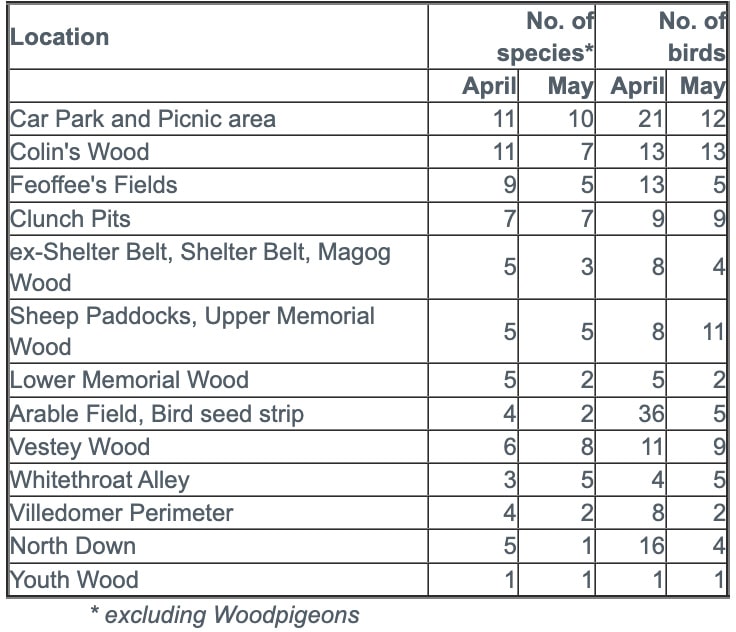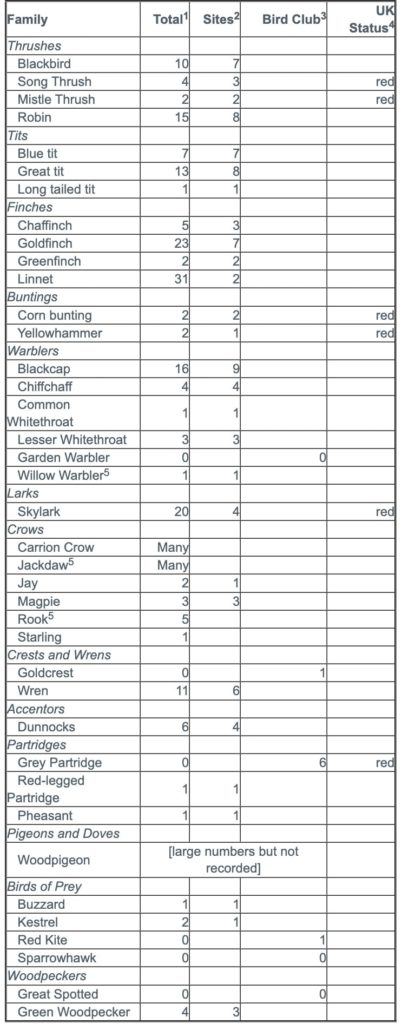2019 Report of a long term survey of breeding birds on Magog Down Stapleford
Bryan Davies, Mike Foley and Robin Cox, all of Cambridgeshire Bird Club.
Summary
The aim of this long term bird survey is to identify permanent gains or losses in the species breeding on the Down. Consequently the same survey route is walked each year on two occasions, one in April and one in May. This is the eighth year of the survey.
Thirty species were probably breeding on the Down this year, two more than the long term average of 28. All the Red listed species (Table 2) were recorded again with skylark numbers up on previous years. Other birds well represented were Blackbird, Robin, Blue and Great Tits, Goldfinch, Linnet, Blackcap, Wren, Dunnock and Green Woodpecker. A Willow Warbler and a Reed Bunting were heard in the car park area during the first survey but both had left before breeding. No Bullfinches were seen or heard. It is several years since a Lesser Whitethroat has been heard on the Down but this year three were heard in three locations during the second survey and probably all were breeding. By contrast Common Whitethroat numbers were well down probably due to the coppicing to remove brambles along sections of ‘Whitethroat Alley’. The large number of Linnets recorded during the April survey were feeding in the Bird Seed Strip which, by the time of the May survey, had been cultivated prior to re-sowing. A few Linnets remain to breed on site each year but the large majority move away. A large number of Corvids were recorded as in previous years but probably only Magpies, Jays and perhaps an occasional Carrion Crow bred in the woods.
A recent survey of invertebrates on the Down has shown that there is a very healthy population of a wide range of insects which suggests that the availability of food is unlikely to be limiting rearing of chicks. So it is interesting to speculate why over the eight years of the survey both bird numbers and the number of species stays similar from year to year rather than increasing. Predation by grey squirrels, magpies and badgers is likely to be the main constraint on bird numbers. Other limiting factors are likely to be insufficient habitats for nesting particularly in the young woods, absence of water and unintentional disturbance by visitors and their dogs.
Field Visits
Survey visits were made on 15 April 2019 and 20 May 2019. The same route was taken as in previous years (for details of the fieldwork methods, see Appendix 1 from 2012 report, available here).
Results
See Tables 1 and 2, below.
Table 1: Breeding species recorded at 13 locations, on each visit

Table 2: Species probably breeding on Magog Down in 2019

1 Sum of the number of birds recorded at each location
2 See Table 1
3 Stapleford Bird Club records from within the survey period are included when they add to the species list or reinforce the absences o
4 Species on the UK Red List, ie that have declined by >50% in the last 40 years.
5 Unlikely to be breeding on Magog Down.
August 2019
